Comprehensive Case Study: Diabetic Retinopathy Management (NURS 2024)
VerifiedAdded on 2022/09/09
|12
|3056
|16
Case Study
AI Summary
This case study focuses on Mr. Hank Jackson, a 64-year-old man with diabetic retinopathy, hypertension, and type 2 diabetes. The report details his medical history, current medications (metformin and metoprolol), and the impact of his conditions on his vision and daily life. The primary medical diagn...
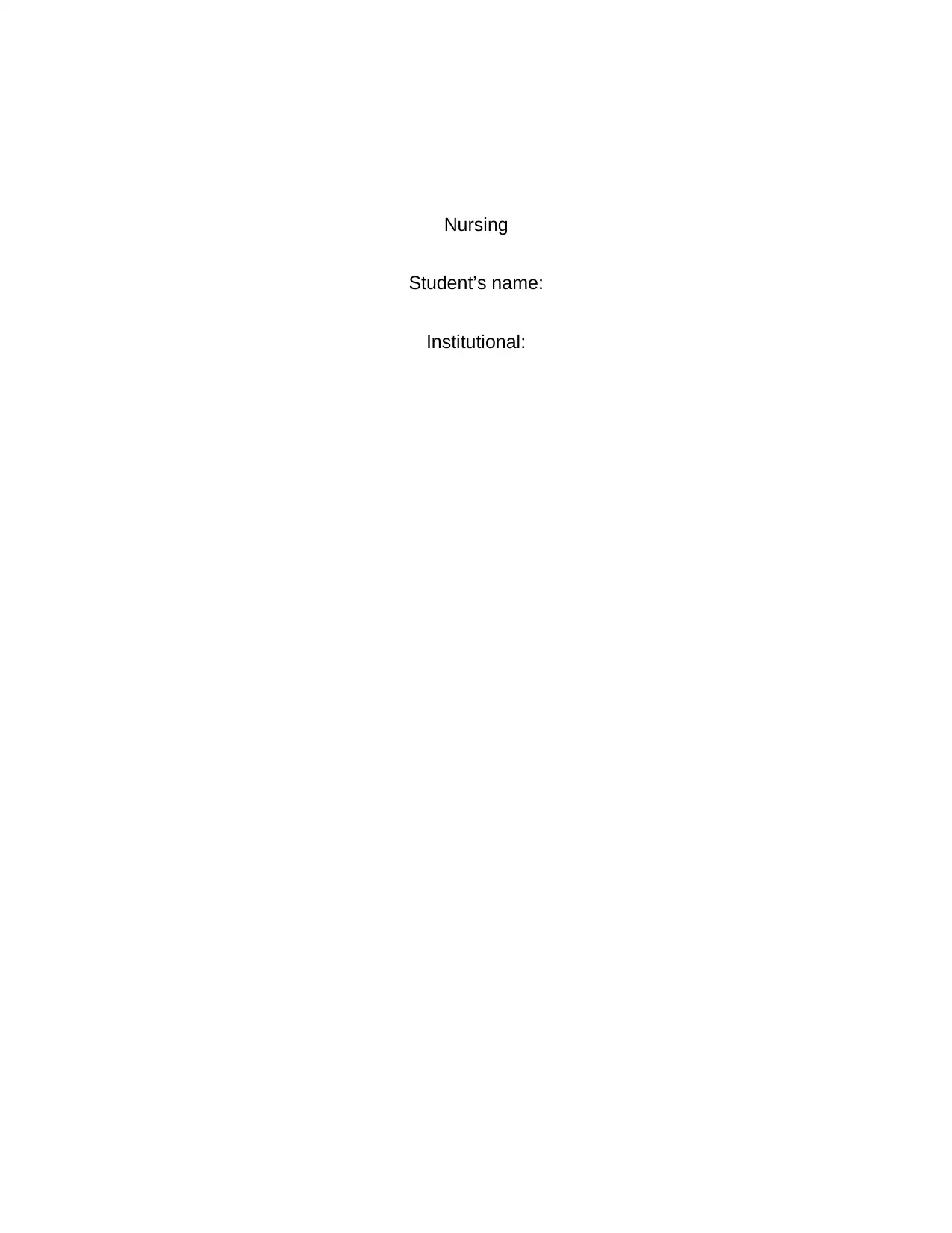
Nursing
Student’s name:
Institutional:
Student’s name:
Institutional:
Paraphrase This Document
Need a fresh take? Get an instant paraphrase of this document with our AI Paraphraser

Diabetic retinopathy
Introduction
Mr Hank Jackson is a 64-year-old man who recently retired as a truck driver. The
reason for his retirement is impaired vision due to diabetic retinopathy as he reports he
has never been sick before. He has a past medical history of type 2 diabetes mellitus
diagnosed five years ago, and hypertension diagnosed seven years ago. He is currently
on medication for the two conditions he is taking metformin and metoprolol. However,
he does not measure his blood sugar at home as he reports that there is no need since
the doctor already knows that his blood sugars are high.
He lives alone in a single-storey home and enjoys cooking and making home brews. He
also likes reading but has been having problems due to impaired vision, and he has one
daughter who lives in interstates. He reports that he does not want to be moved from his
home, therefore, making it necessary for an inter-professional community plan of care.
The purpose of this report is to identify Mr Jackson's problems and be able to manage
them inter-professionally. The structure of the report will outline the introduction,
medical management of Mr Hank's condition, nursing management of his condition, the
role of a nurse in the inter-professional plan of care and finally the conclusion.
Primary medical diagnosis
Mr Hank’s primary diagnosis is diabetic retinopathy. Diabetic retinopathy is an eye
condition that is caused by damage of the blood vessels supplying the retina (a light-
sensitive tissue) of the eye (Solomon et al. 2017). This condition starts with mild vision
impairment and eventually leads to blindness either of one eye or both eyes. The main
Introduction
Mr Hank Jackson is a 64-year-old man who recently retired as a truck driver. The
reason for his retirement is impaired vision due to diabetic retinopathy as he reports he
has never been sick before. He has a past medical history of type 2 diabetes mellitus
diagnosed five years ago, and hypertension diagnosed seven years ago. He is currently
on medication for the two conditions he is taking metformin and metoprolol. However,
he does not measure his blood sugar at home as he reports that there is no need since
the doctor already knows that his blood sugars are high.
He lives alone in a single-storey home and enjoys cooking and making home brews. He
also likes reading but has been having problems due to impaired vision, and he has one
daughter who lives in interstates. He reports that he does not want to be moved from his
home, therefore, making it necessary for an inter-professional community plan of care.
The purpose of this report is to identify Mr Jackson's problems and be able to manage
them inter-professionally. The structure of the report will outline the introduction,
medical management of Mr Hank's condition, nursing management of his condition, the
role of a nurse in the inter-professional plan of care and finally the conclusion.
Primary medical diagnosis
Mr Hank’s primary diagnosis is diabetic retinopathy. Diabetic retinopathy is an eye
condition that is caused by damage of the blood vessels supplying the retina (a light-
sensitive tissue) of the eye (Solomon et al. 2017). This condition starts with mild vision
impairment and eventually leads to blindness either of one eye or both eyes. The main
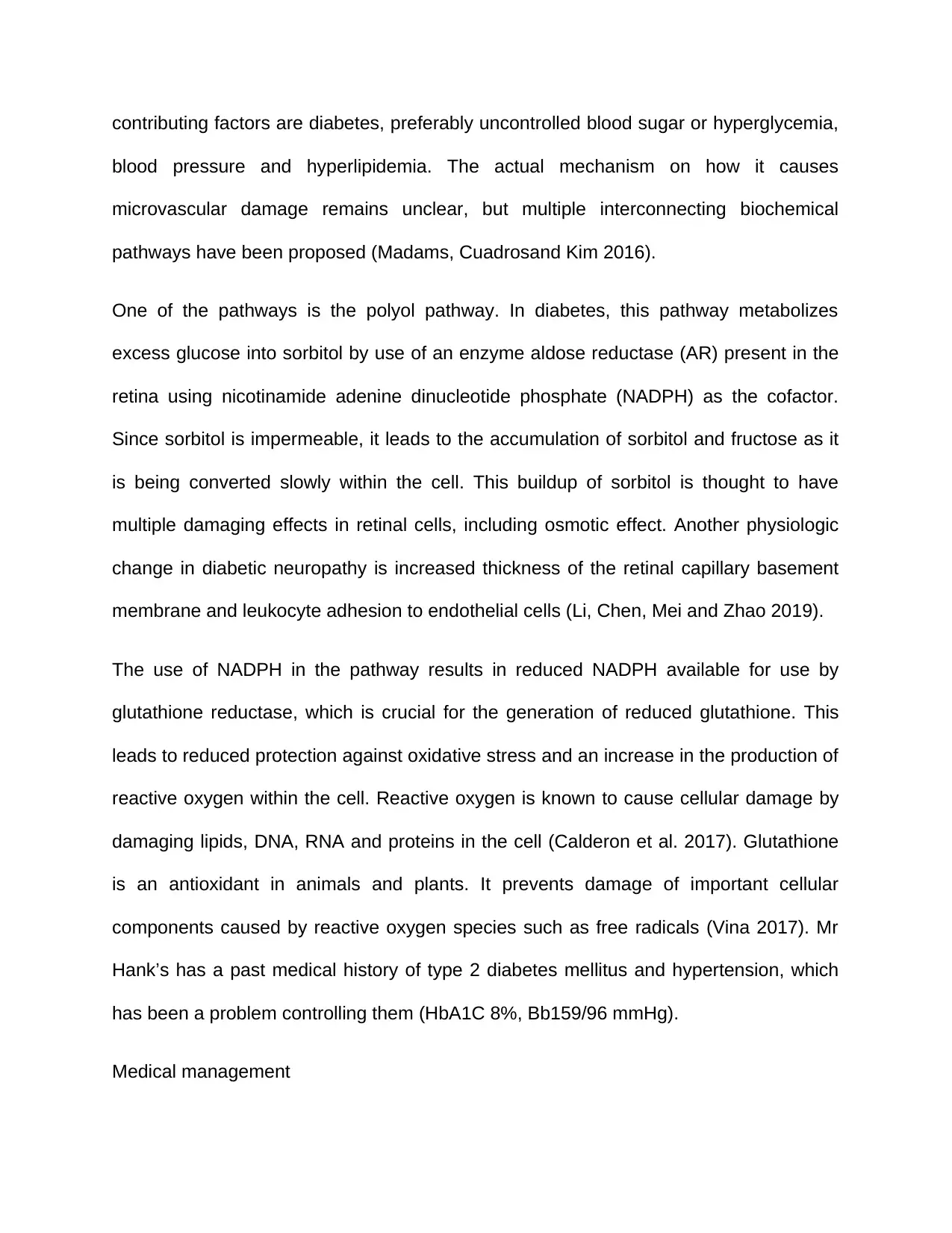
contributing factors are diabetes, preferably uncontrolled blood sugar or hyperglycemia,
blood pressure and hyperlipidemia. The actual mechanism on how it causes
microvascular damage remains unclear, but multiple interconnecting biochemical
pathways have been proposed (Madams, Cuadrosand Kim 2016).
One of the pathways is the polyol pathway. In diabetes, this pathway metabolizes
excess glucose into sorbitol by use of an enzyme aldose reductase (AR) present in the
retina using nicotinamide adenine dinucleotide phosphate (NADPH) as the cofactor.
Since sorbitol is impermeable, it leads to the accumulation of sorbitol and fructose as it
is being converted slowly within the cell. This buildup of sorbitol is thought to have
multiple damaging effects in retinal cells, including osmotic effect. Another physiologic
change in diabetic neuropathy is increased thickness of the retinal capillary basement
membrane and leukocyte adhesion to endothelial cells (Li, Chen, Mei and Zhao 2019).
The use of NADPH in the pathway results in reduced NADPH available for use by
glutathione reductase, which is crucial for the generation of reduced glutathione. This
leads to reduced protection against oxidative stress and an increase in the production of
reactive oxygen within the cell. Reactive oxygen is known to cause cellular damage by
damaging lipids, DNA, RNA and proteins in the cell (Calderon et al. 2017). Glutathione
is an antioxidant in animals and plants. It prevents damage of important cellular
components caused by reactive oxygen species such as free radicals (Vina 2017). Mr
Hank’s has a past medical history of type 2 diabetes mellitus and hypertension, which
has been a problem controlling them (HbA1C 8%, Bb159/96 mmHg).
Medical management
blood pressure and hyperlipidemia. The actual mechanism on how it causes
microvascular damage remains unclear, but multiple interconnecting biochemical
pathways have been proposed (Madams, Cuadrosand Kim 2016).
One of the pathways is the polyol pathway. In diabetes, this pathway metabolizes
excess glucose into sorbitol by use of an enzyme aldose reductase (AR) present in the
retina using nicotinamide adenine dinucleotide phosphate (NADPH) as the cofactor.
Since sorbitol is impermeable, it leads to the accumulation of sorbitol and fructose as it
is being converted slowly within the cell. This buildup of sorbitol is thought to have
multiple damaging effects in retinal cells, including osmotic effect. Another physiologic
change in diabetic neuropathy is increased thickness of the retinal capillary basement
membrane and leukocyte adhesion to endothelial cells (Li, Chen, Mei and Zhao 2019).
The use of NADPH in the pathway results in reduced NADPH available for use by
glutathione reductase, which is crucial for the generation of reduced glutathione. This
leads to reduced protection against oxidative stress and an increase in the production of
reactive oxygen within the cell. Reactive oxygen is known to cause cellular damage by
damaging lipids, DNA, RNA and proteins in the cell (Calderon et al. 2017). Glutathione
is an antioxidant in animals and plants. It prevents damage of important cellular
components caused by reactive oxygen species such as free radicals (Vina 2017). Mr
Hank’s has a past medical history of type 2 diabetes mellitus and hypertension, which
has been a problem controlling them (HbA1C 8%, Bb159/96 mmHg).
Medical management
⊘ This is a preview!⊘
Do you want full access?
Subscribe today to unlock all pages.

Trusted by 1+ million students worldwide

Mr Hank is currently taking Metformin 500 mg twice a day and Metoprolol 50 mg twice a
day. Metformin is an antidiabetic drug of the biguanide class. It has multiple sites of
action and lowers blood sugar level by acting either directly or indirectly on the liver to
lower glucose production. It also acts on the gut to increase utilization of glucose and
increases GLP-1. It also lowers blood glucose levels by increasing muscle sensitivity to
insulin and can also alter the microbiome (Rena, Hardie and Pearson 2017).
Metformin is used to manage type 2 diabetes mellitus, especially in adults. The main
side effects include lactic acidosis, nausea and vomiting. Other side effects include
diarrhea, flatulence, asthenia, and reduces vitamin b12 serum concentrate. Blood sugar
level should be measure before giving metformin if hypoglycemic withhold the
medication (Seelig et al. 2017).
Metoprolol is a selective beta-1 adrenergic receptor blocker. It is cardioselective at
normal dosage. However, at high plasma concentration, it can inhibit beta-2 receptors
located at the arteries of skeletal muscles and bronchial muscles. Beta-1 receptors are
located in the heart. Their main function is to increase cardiac muscle contractility and
increase heart rate (Morris and Dunham 2018).
Metoprolol is used to manage hypertension, angina pectoris and prevention of
myocardial infarction and to lower mortality rate in patient with recurring MI. It can also
be used in managing stable symptomatic heart failure of class II and III. It can also be
used in combination with ACE inhibitors and diuretics. Its main side effects include
dizziness, depression, dry mouth and nausea. It can also cause tiredness, dry mouth,
vomiting, gas and bloating and stomach pain. Long-term use of metoprolol can damage
day. Metformin is an antidiabetic drug of the biguanide class. It has multiple sites of
action and lowers blood sugar level by acting either directly or indirectly on the liver to
lower glucose production. It also acts on the gut to increase utilization of glucose and
increases GLP-1. It also lowers blood glucose levels by increasing muscle sensitivity to
insulin and can also alter the microbiome (Rena, Hardie and Pearson 2017).
Metformin is used to manage type 2 diabetes mellitus, especially in adults. The main
side effects include lactic acidosis, nausea and vomiting. Other side effects include
diarrhea, flatulence, asthenia, and reduces vitamin b12 serum concentrate. Blood sugar
level should be measure before giving metformin if hypoglycemic withhold the
medication (Seelig et al. 2017).
Metoprolol is a selective beta-1 adrenergic receptor blocker. It is cardioselective at
normal dosage. However, at high plasma concentration, it can inhibit beta-2 receptors
located at the arteries of skeletal muscles and bronchial muscles. Beta-1 receptors are
located in the heart. Their main function is to increase cardiac muscle contractility and
increase heart rate (Morris and Dunham 2018).
Metoprolol is used to manage hypertension, angina pectoris and prevention of
myocardial infarction and to lower mortality rate in patient with recurring MI. It can also
be used in managing stable symptomatic heart failure of class II and III. It can also be
used in combination with ACE inhibitors and diuretics. Its main side effects include
dizziness, depression, dry mouth and nausea. It can also cause tiredness, dry mouth,
vomiting, gas and bloating and stomach pain. Long-term use of metoprolol can damage
Paraphrase This Document
Need a fresh take? Get an instant paraphrase of this document with our AI Paraphraser
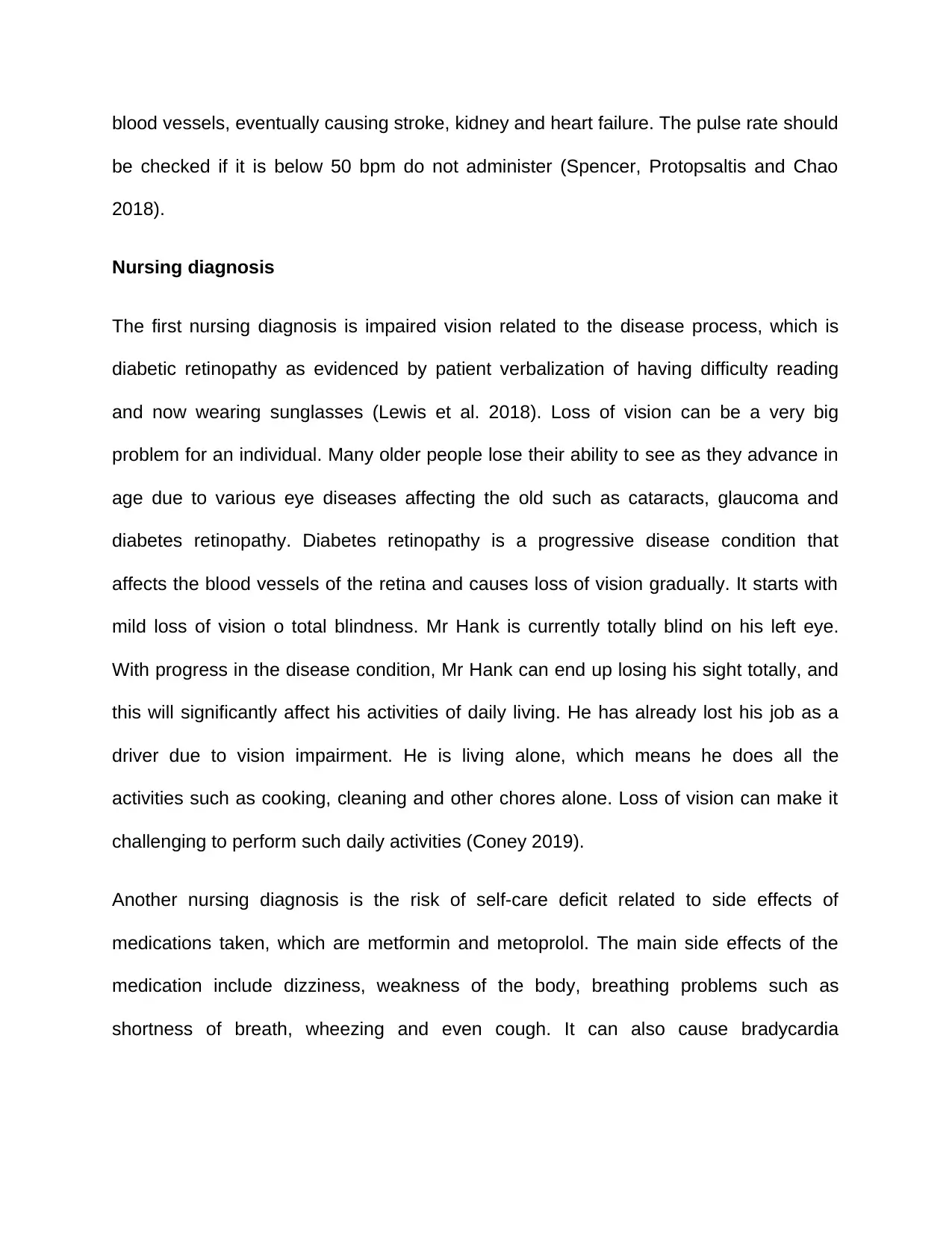
blood vessels, eventually causing stroke, kidney and heart failure. The pulse rate should
be checked if it is below 50 bpm do not administer (Spencer, Protopsaltis and Chao
2018).
Nursing diagnosis
The first nursing diagnosis is impaired vision related to the disease process, which is
diabetic retinopathy as evidenced by patient verbalization of having difficulty reading
and now wearing sunglasses (Lewis et al. 2018). Loss of vision can be a very big
problem for an individual. Many older people lose their ability to see as they advance in
age due to various eye diseases affecting the old such as cataracts, glaucoma and
diabetes retinopathy. Diabetes retinopathy is a progressive disease condition that
affects the blood vessels of the retina and causes loss of vision gradually. It starts with
mild loss of vision o total blindness. Mr Hank is currently totally blind on his left eye.
With progress in the disease condition, Mr Hank can end up losing his sight totally, and
this will significantly affect his activities of daily living. He has already lost his job as a
driver due to vision impairment. He is living alone, which means he does all the
activities such as cooking, cleaning and other chores alone. Loss of vision can make it
challenging to perform such daily activities (Coney 2019).
Another nursing diagnosis is the risk of self-care deficit related to side effects of
medications taken, which are metformin and metoprolol. The main side effects of the
medication include dizziness, weakness of the body, breathing problems such as
shortness of breath, wheezing and even cough. It can also cause bradycardia
be checked if it is below 50 bpm do not administer (Spencer, Protopsaltis and Chao
2018).
Nursing diagnosis
The first nursing diagnosis is impaired vision related to the disease process, which is
diabetic retinopathy as evidenced by patient verbalization of having difficulty reading
and now wearing sunglasses (Lewis et al. 2018). Loss of vision can be a very big
problem for an individual. Many older people lose their ability to see as they advance in
age due to various eye diseases affecting the old such as cataracts, glaucoma and
diabetes retinopathy. Diabetes retinopathy is a progressive disease condition that
affects the blood vessels of the retina and causes loss of vision gradually. It starts with
mild loss of vision o total blindness. Mr Hank is currently totally blind on his left eye.
With progress in the disease condition, Mr Hank can end up losing his sight totally, and
this will significantly affect his activities of daily living. He has already lost his job as a
driver due to vision impairment. He is living alone, which means he does all the
activities such as cooking, cleaning and other chores alone. Loss of vision can make it
challenging to perform such daily activities (Coney 2019).
Another nursing diagnosis is the risk of self-care deficit related to side effects of
medications taken, which are metformin and metoprolol. The main side effects of the
medication include dizziness, weakness of the body, breathing problems such as
shortness of breath, wheezing and even cough. It can also cause bradycardia

(metoprolol), especially when used long term and hypoglycemia (metformin) can also
result (Lannicelli et al. 2019).
Mr Hank is living alone and does all the activities alone. With the side effects of these
medications, he might have a problem in carrying out his activities due to tiredness and
weakness. Some effects such as nausea, vomiting and diarrhea contribute more to his
weakness and therefore making it difficult to perform the task due to reduced energy
levels. Loss of fluid through vomiting and diarrhea contributes to loss of energy. Long-
term use of metoprolol has also been found to cause organ failure, especially the brain,
the heart and the kidney. Loss of function or failure of these organs greatly affects the
normal body physiology.
Role of a nurse and inter-professional plan of care
Inter-professional plan of care is the involvement of various healthcare professional in
the management of a patient according to the area of their specialization. This is taking
care of the patient holistically. A nurse plays an important role in the management of
patients as they spend more time with their patients than any other healthcare
professional. A community health nurse manages patients, especially at a community
level. They are able to visit clients at their place of residence and identify patient's
health problems through assessment. Patients' problems can be due to a pre-existing
medical condition, environmental problem or even a social problem. Once these
problems are identified, appropriate interventions are put into place to ensure the
patient has an improved state of living (Gulshan et al. 2016).
result (Lannicelli et al. 2019).
Mr Hank is living alone and does all the activities alone. With the side effects of these
medications, he might have a problem in carrying out his activities due to tiredness and
weakness. Some effects such as nausea, vomiting and diarrhea contribute more to his
weakness and therefore making it difficult to perform the task due to reduced energy
levels. Loss of fluid through vomiting and diarrhea contributes to loss of energy. Long-
term use of metoprolol has also been found to cause organ failure, especially the brain,
the heart and the kidney. Loss of function or failure of these organs greatly affects the
normal body physiology.
Role of a nurse and inter-professional plan of care
Inter-professional plan of care is the involvement of various healthcare professional in
the management of a patient according to the area of their specialization. This is taking
care of the patient holistically. A nurse plays an important role in the management of
patients as they spend more time with their patients than any other healthcare
professional. A community health nurse manages patients, especially at a community
level. They are able to visit clients at their place of residence and identify patient's
health problems through assessment. Patients' problems can be due to a pre-existing
medical condition, environmental problem or even a social problem. Once these
problems are identified, appropriate interventions are put into place to ensure the
patient has an improved state of living (Gulshan et al. 2016).
⊘ This is a preview!⊘
Do you want full access?
Subscribe today to unlock all pages.

Trusted by 1+ million students worldwide

Mr Hank's primary diagnosis is diabetic retinopathy. Apart from the primary problem,
other problems such as impaired vision risk of self-care deficit need to be managed.
Professionals involved in the management of Mr Hank's condition include Doctors,
Ophthalmologists, Nurses, Nutritionist, Social Worker and Public Health Officer. The
role of an ophthalmologist is the treatment and management of diabetic retinopathy.
This condition can be treated through surgery (Vitrectomy) or laser treatment in order to
prevent further vascular changes and to preserve vision. This prevents the progress of
the condition. Vision can be restored depending on the stage of the condition when
surgery was performed (Cavan et al. 2017).
Diabetic neuropathy can also be managed by effectively controlling blood glucose within
the normal range. The role of a doctor is to prescribe an appropriate treatment regimen
for the patient and a way to ensure that the regimen is followed. From the case study,
there is evidence of uncontrolled blood sugar as Mr Hank's HbA1C is 8% (normal 4-
5.9%) even with the administration of metformin 500mg twice daily. The drug can be
changed to insulin administration or any other medication appropriate for this patient.
Appropriate medication to manage medication side effects can also be prescribed (Duh,
Sun and Stitt 2017).
The first role of a community health nurse is patient education. The nurse should
educate the patient on their disease condition, the cause, predisposing factors and even
the treatment. The patient should be informed on the relationship between the eye
condition and his past illnesses such as diabetes and hypertension. He should also be
informed on the importance of adhering to medication prescribed in order to control
blood pressure and blood glucose level and the importance of this control to the current
other problems such as impaired vision risk of self-care deficit need to be managed.
Professionals involved in the management of Mr Hank's condition include Doctors,
Ophthalmologists, Nurses, Nutritionist, Social Worker and Public Health Officer. The
role of an ophthalmologist is the treatment and management of diabetic retinopathy.
This condition can be treated through surgery (Vitrectomy) or laser treatment in order to
prevent further vascular changes and to preserve vision. This prevents the progress of
the condition. Vision can be restored depending on the stage of the condition when
surgery was performed (Cavan et al. 2017).
Diabetic neuropathy can also be managed by effectively controlling blood glucose within
the normal range. The role of a doctor is to prescribe an appropriate treatment regimen
for the patient and a way to ensure that the regimen is followed. From the case study,
there is evidence of uncontrolled blood sugar as Mr Hank's HbA1C is 8% (normal 4-
5.9%) even with the administration of metformin 500mg twice daily. The drug can be
changed to insulin administration or any other medication appropriate for this patient.
Appropriate medication to manage medication side effects can also be prescribed (Duh,
Sun and Stitt 2017).
The first role of a community health nurse is patient education. The nurse should
educate the patient on their disease condition, the cause, predisposing factors and even
the treatment. The patient should be informed on the relationship between the eye
condition and his past illnesses such as diabetes and hypertension. He should also be
informed on the importance of adhering to medication prescribed in order to control
blood pressure and blood glucose level and the importance of this control to the current
Paraphrase This Document
Need a fresh take? Get an instant paraphrase of this document with our AI Paraphraser
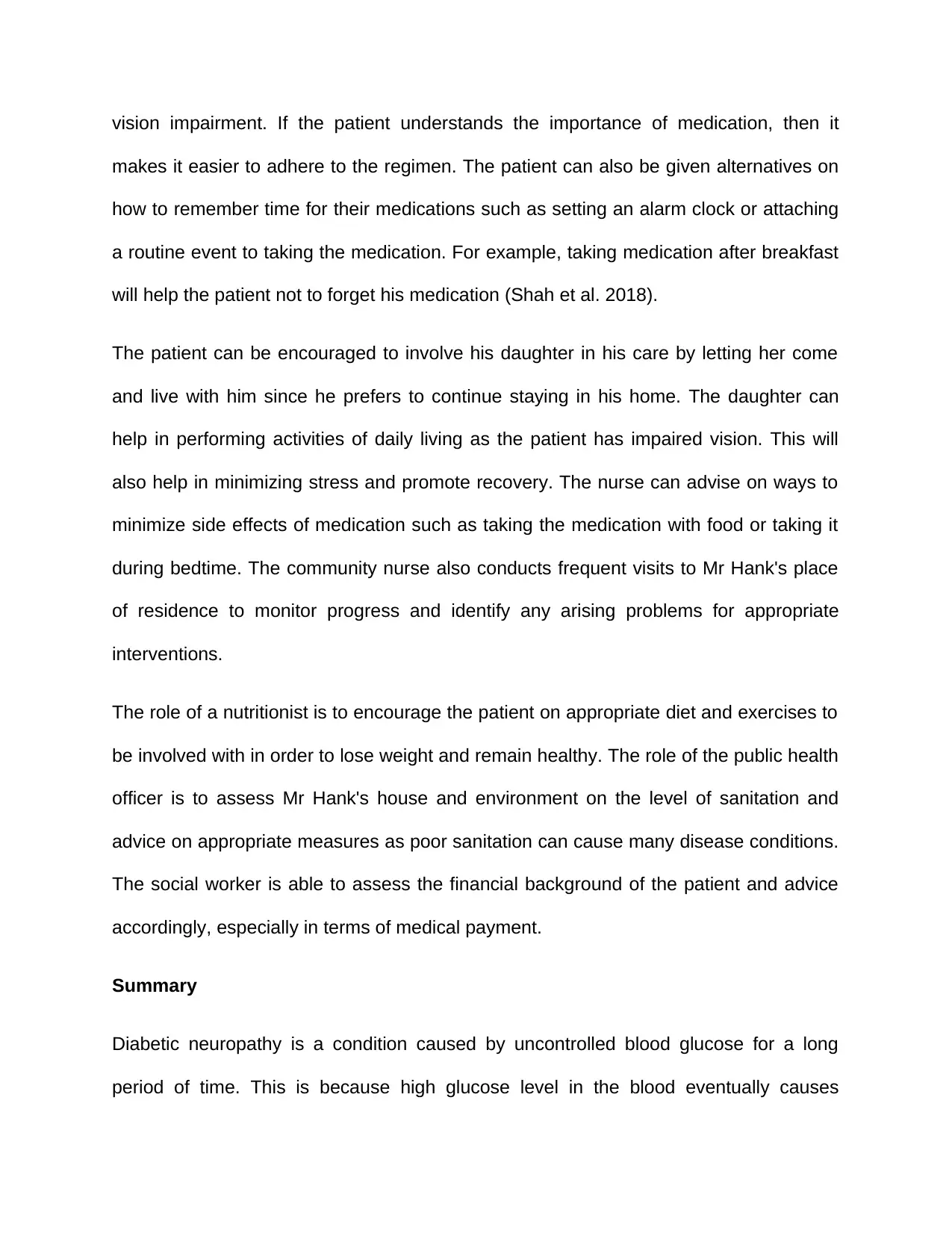
vision impairment. If the patient understands the importance of medication, then it
makes it easier to adhere to the regimen. The patient can also be given alternatives on
how to remember time for their medications such as setting an alarm clock or attaching
a routine event to taking the medication. For example, taking medication after breakfast
will help the patient not to forget his medication (Shah et al. 2018).
The patient can be encouraged to involve his daughter in his care by letting her come
and live with him since he prefers to continue staying in his home. The daughter can
help in performing activities of daily living as the patient has impaired vision. This will
also help in minimizing stress and promote recovery. The nurse can advise on ways to
minimize side effects of medication such as taking the medication with food or taking it
during bedtime. The community nurse also conducts frequent visits to Mr Hank's place
of residence to monitor progress and identify any arising problems for appropriate
interventions.
The role of a nutritionist is to encourage the patient on appropriate diet and exercises to
be involved with in order to lose weight and remain healthy. The role of the public health
officer is to assess Mr Hank's house and environment on the level of sanitation and
advice on appropriate measures as poor sanitation can cause many disease conditions.
The social worker is able to assess the financial background of the patient and advice
accordingly, especially in terms of medical payment.
Summary
Diabetic neuropathy is a condition caused by uncontrolled blood glucose for a long
period of time. This is because high glucose level in the blood eventually causes
makes it easier to adhere to the regimen. The patient can also be given alternatives on
how to remember time for their medications such as setting an alarm clock or attaching
a routine event to taking the medication. For example, taking medication after breakfast
will help the patient not to forget his medication (Shah et al. 2018).
The patient can be encouraged to involve his daughter in his care by letting her come
and live with him since he prefers to continue staying in his home. The daughter can
help in performing activities of daily living as the patient has impaired vision. This will
also help in minimizing stress and promote recovery. The nurse can advise on ways to
minimize side effects of medication such as taking the medication with food or taking it
during bedtime. The community nurse also conducts frequent visits to Mr Hank's place
of residence to monitor progress and identify any arising problems for appropriate
interventions.
The role of a nutritionist is to encourage the patient on appropriate diet and exercises to
be involved with in order to lose weight and remain healthy. The role of the public health
officer is to assess Mr Hank's house and environment on the level of sanitation and
advice on appropriate measures as poor sanitation can cause many disease conditions.
The social worker is able to assess the financial background of the patient and advice
accordingly, especially in terms of medical payment.
Summary
Diabetic neuropathy is a condition caused by uncontrolled blood glucose for a long
period of time. This is because high glucose level in the blood eventually causes
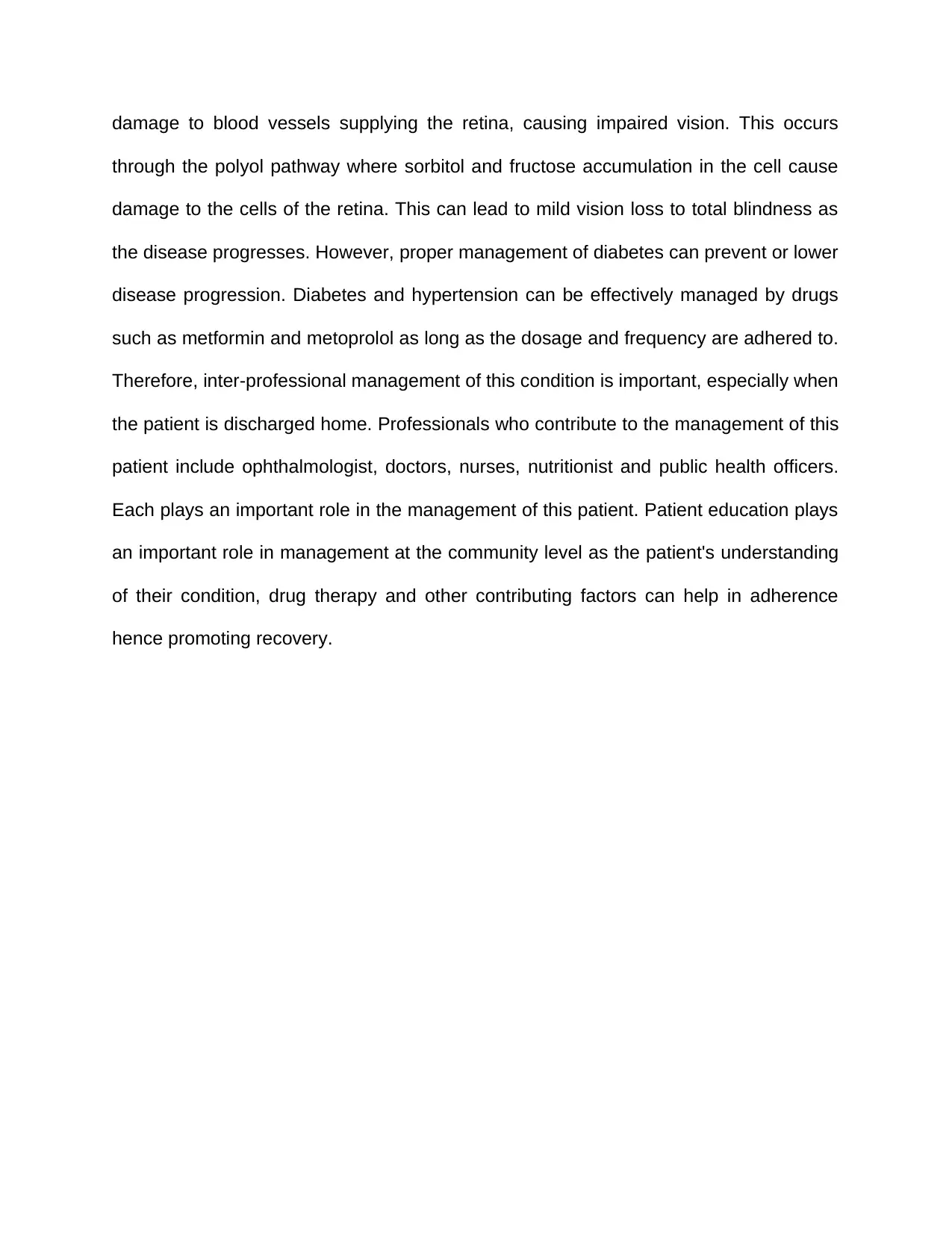
damage to blood vessels supplying the retina, causing impaired vision. This occurs
through the polyol pathway where sorbitol and fructose accumulation in the cell cause
damage to the cells of the retina. This can lead to mild vision loss to total blindness as
the disease progresses. However, proper management of diabetes can prevent or lower
disease progression. Diabetes and hypertension can be effectively managed by drugs
such as metformin and metoprolol as long as the dosage and frequency are adhered to.
Therefore, inter-professional management of this condition is important, especially when
the patient is discharged home. Professionals who contribute to the management of this
patient include ophthalmologist, doctors, nurses, nutritionist and public health officers.
Each plays an important role in the management of this patient. Patient education plays
an important role in management at the community level as the patient's understanding
of their condition, drug therapy and other contributing factors can help in adherence
hence promoting recovery.
through the polyol pathway where sorbitol and fructose accumulation in the cell cause
damage to the cells of the retina. This can lead to mild vision loss to total blindness as
the disease progresses. However, proper management of diabetes can prevent or lower
disease progression. Diabetes and hypertension can be effectively managed by drugs
such as metformin and metoprolol as long as the dosage and frequency are adhered to.
Therefore, inter-professional management of this condition is important, especially when
the patient is discharged home. Professionals who contribute to the management of this
patient include ophthalmologist, doctors, nurses, nutritionist and public health officers.
Each plays an important role in the management of this patient. Patient education plays
an important role in management at the community level as the patient's understanding
of their condition, drug therapy and other contributing factors can help in adherence
hence promoting recovery.
⊘ This is a preview!⊘
Do you want full access?
Subscribe today to unlock all pages.

Trusted by 1+ million students worldwide

References
Calderon, G.D., Juarez, O.H., Hernandez, G.E., Punzo, S.M. and De la Cruz, Z.D.,
2017. Oxidative stress and diabetic retinopathy: development and treatment. Eye, 31(8),
pp.1122-1130.
Cavan, D., Makaroff, L., da Rocha Fernandes, J., Sylvanowicz, M., Ackland, P., Conlon,
J., Chaney, D., Malhi, A. and Barratt, J., 2017. The diabetic retinopathy barometer
study: global perspectives on access to and experiences of diabetic retinopathy
screening and treatment: diabetes research and clinical practice, 129, pp.16-24.
Coney, J.M., 2019. Addressing unmet needs in diabetic retinopathy. The American
journal of managed care, 25(16 Suppl), pp. S311-S316.
Duh, E.J., Sun, J.K. and Stitt, A.W., 2017. Diabetic retinopathy: current understanding,
mechanisms, and treatment strategies. JCI insight, 2(14).
Gulshan, V., Peng, L., Coram, M., Stumpe, M.C., Wu, D., Narayanaswamy, A.,
Venugopalan, S., Widner, K., Madams, T., Cuadros, J. and Kim, R., 2016. Development
and validation of a deep learning algorithm for the detection of diabetic retinopathy in
retinal fundus photographs. Jama, 316(22), pp.2402-2410.
Iannicelli, A.M., De Matteo, P., Vito, D., Pellecchia, E., Dodaro, C., Giallauria, F. and
Vigorito, C., 2019. Use of the North American Nursing Diagnosis Association
taxonomies, Nursing Intervention Classification, Nursing Outcomes Classification and
NANDA-NIC-NOC linkage in cardiac rehabilitation. Monaldi Archives for Chest Disease,
89(2).
Calderon, G.D., Juarez, O.H., Hernandez, G.E., Punzo, S.M. and De la Cruz, Z.D.,
2017. Oxidative stress and diabetic retinopathy: development and treatment. Eye, 31(8),
pp.1122-1130.
Cavan, D., Makaroff, L., da Rocha Fernandes, J., Sylvanowicz, M., Ackland, P., Conlon,
J., Chaney, D., Malhi, A. and Barratt, J., 2017. The diabetic retinopathy barometer
study: global perspectives on access to and experiences of diabetic retinopathy
screening and treatment: diabetes research and clinical practice, 129, pp.16-24.
Coney, J.M., 2019. Addressing unmet needs in diabetic retinopathy. The American
journal of managed care, 25(16 Suppl), pp. S311-S316.
Duh, E.J., Sun, J.K. and Stitt, A.W., 2017. Diabetic retinopathy: current understanding,
mechanisms, and treatment strategies. JCI insight, 2(14).
Gulshan, V., Peng, L., Coram, M., Stumpe, M.C., Wu, D., Narayanaswamy, A.,
Venugopalan, S., Widner, K., Madams, T., Cuadros, J. and Kim, R., 2016. Development
and validation of a deep learning algorithm for the detection of diabetic retinopathy in
retinal fundus photographs. Jama, 316(22), pp.2402-2410.
Iannicelli, A.M., De Matteo, P., Vito, D., Pellecchia, E., Dodaro, C., Giallauria, F. and
Vigorito, C., 2019. Use of the North American Nursing Diagnosis Association
taxonomies, Nursing Intervention Classification, Nursing Outcomes Classification and
NANDA-NIC-NOC linkage in cardiac rehabilitation. Monaldi Archives for Chest Disease,
89(2).
Paraphrase This Document
Need a fresh take? Get an instant paraphrase of this document with our AI Paraphraser

Lewis, A.D., Hogg, R.E., Chandran, M., Musonda, L., North, L., Chakravarthy, U.,
Sivaprasad, S. and Menon, G., 2018. Prevalence of diabetic retinopathy and visual
impairment in patients with diabetes mellitus in Zambia through the implementation of a
mobile diabetic retinopathy screening project in the Copperbelt province: a cross-
sectional study. Eye, 32(7), pp.1201-1208.
Li, W., Chen, S., Mei, Z., Zhao, F. and Xiang, Y., 2019. Polymorphisms in Sorbitol-
Aldose Reductase (Polyol) Pathway Genes and Their Influence on Risk of Diabetic
Retinopathy Among Han Chinese. Medical science monitor: international medical
journal of experimental and clinical research, 25, p.7073.
Morris, J. and Dunham, A., 2018. Metoprolol. In StatPearls [Internet]. StatPearls
Publishing.
Rena, G., Hardie, D.G. and Pearson, E.R., 2017. The mechanisms of action of
metformin. Diabetologia, 60(9), pp.1577-1585.
Seelig, E., Meyer, S., Timper, K., Nigro, N., Bally, M., Pernicova, I., Schuetz, P., Müller,
B., Korbonits, M. and Christ-Crain, M., 2017. Metformin prevents metabolic side effects
during systemic glucocorticoid treatment. Eur J Endocrinol.
Shah, M., Ormsby, G.M., Noor, A., Chakrabarti, R., Mörchen, M., Islam, F.M.A., Harper,
C.A. and Keeffe, J.E., 2018. Roles of the eye care workforce for task-sharing in
management of diabetic retinopathy in Cambodia. International journal of
ophthalmology, 11(1), p.101.
Sivaprasad, S. and Menon, G., 2018. Prevalence of diabetic retinopathy and visual
impairment in patients with diabetes mellitus in Zambia through the implementation of a
mobile diabetic retinopathy screening project in the Copperbelt province: a cross-
sectional study. Eye, 32(7), pp.1201-1208.
Li, W., Chen, S., Mei, Z., Zhao, F. and Xiang, Y., 2019. Polymorphisms in Sorbitol-
Aldose Reductase (Polyol) Pathway Genes and Their Influence on Risk of Diabetic
Retinopathy Among Han Chinese. Medical science monitor: international medical
journal of experimental and clinical research, 25, p.7073.
Morris, J. and Dunham, A., 2018. Metoprolol. In StatPearls [Internet]. StatPearls
Publishing.
Rena, G., Hardie, D.G. and Pearson, E.R., 2017. The mechanisms of action of
metformin. Diabetologia, 60(9), pp.1577-1585.
Seelig, E., Meyer, S., Timper, K., Nigro, N., Bally, M., Pernicova, I., Schuetz, P., Müller,
B., Korbonits, M. and Christ-Crain, M., 2017. Metformin prevents metabolic side effects
during systemic glucocorticoid treatment. Eur J Endocrinol.
Shah, M., Ormsby, G.M., Noor, A., Chakrabarti, R., Mörchen, M., Islam, F.M.A., Harper,
C.A. and Keeffe, J.E., 2018. Roles of the eye care workforce for task-sharing in
management of diabetic retinopathy in Cambodia. International journal of
ophthalmology, 11(1), p.101.
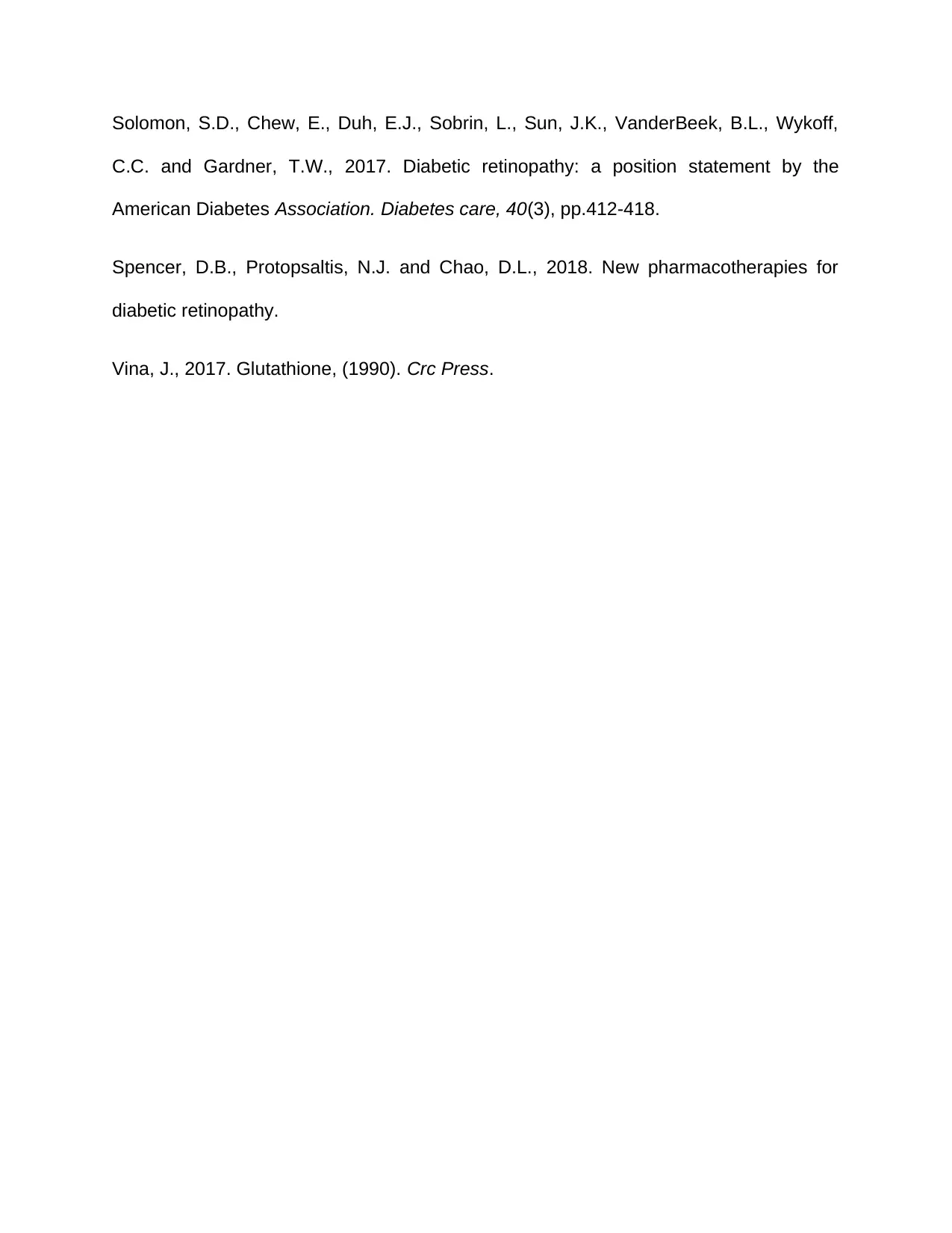
Solomon, S.D., Chew, E., Duh, E.J., Sobrin, L., Sun, J.K., VanderBeek, B.L., Wykoff,
C.C. and Gardner, T.W., 2017. Diabetic retinopathy: a position statement by the
American Diabetes Association. Diabetes care, 40(3), pp.412-418.
Spencer, D.B., Protopsaltis, N.J. and Chao, D.L., 2018. New pharmacotherapies for
diabetic retinopathy.
Vina, J., 2017. Glutathione, (1990). Crc Press.
C.C. and Gardner, T.W., 2017. Diabetic retinopathy: a position statement by the
American Diabetes Association. Diabetes care, 40(3), pp.412-418.
Spencer, D.B., Protopsaltis, N.J. and Chao, D.L., 2018. New pharmacotherapies for
diabetic retinopathy.
Vina, J., 2017. Glutathione, (1990). Crc Press.
⊘ This is a preview!⊘
Do you want full access?
Subscribe today to unlock all pages.

Trusted by 1+ million students worldwide
1 out of 12
Related Documents
Your All-in-One AI-Powered Toolkit for Academic Success.
+13062052269
info@desklib.com
Available 24*7 on WhatsApp / Email
![[object Object]](/_next/static/media/star-bottom.7253800d.svg)
Unlock your academic potential
© 2024 | Zucol Services PVT LTD | All rights reserved.





